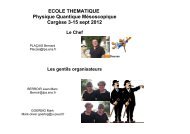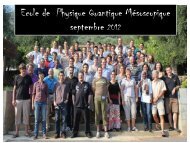Scanning Gate Microscopy (SGM) of semiconductor ... - GDR Meso
Scanning Gate Microscopy (SGM) of semiconductor ... - GDR Meso
Scanning Gate Microscopy (SGM) of semiconductor ... - GDR Meso
You also want an ePaper? Increase the reach of your titles
YUMPU automatically turns print PDFs into web optimized ePapers that Google loves.
<strong>Scanning</strong> <strong>Gate</strong> <strong>Microscopy</strong> (<strong>SGM</strong>)<br />
<strong>of</strong> <strong>semiconductor</strong> nanostructures<br />
H. Sellier, P. Liu, B. Sacépé, S. Huant<br />
Dépt NANO, Institut NEEL, Grenoble, France<br />
B. Hackens, F. Martins, V. Bayot<br />
UCL, Louvain-la-Neuve, Belgique<br />
M. Pala<br />
IMEP, Minatec, Grenoble, France<br />
L. Desplanque, X. Wallart<br />
IEMN, Lille, France<br />
<strong>GDR</strong> 2426 Physique Quantique Mésoscopique<br />
Session thématique « Champ proche »<br />
2 - 4 novembre 2010<br />
1
Outline<br />
1. Description <strong>of</strong> <strong>SGM</strong> technique<br />
- context<br />
- potential<br />
- operation<br />
2. Review <strong>of</strong> <strong>SGM</strong> experiments<br />
- contributors<br />
- microscopes<br />
- quantum point contact<br />
- quantum dot<br />
- quantum Hall effect<br />
- quantum ring<br />
3. ANR project on electron interactions<br />
- objectives<br />
- strategy<br />
2
Introduction to <strong>SGM</strong><br />
Local probe <strong>of</strong> electron properties in <strong>semiconductor</strong> heterostructures<br />
where electrons are several tens <strong>of</strong> nanometers below the surface<br />
thus not accessible by <strong>Scanning</strong> Tunneling <strong>Microscopy</strong><br />
2DEG<br />
• Quantum Point Contact<br />
• Quantum Wire<br />
• Quantum Dot<br />
• Quantum Ring<br />
• Quantum Hall Effect<br />
V<br />
I<br />
V<br />
3
<strong>SGM</strong> versus STM<br />
STM<br />
<strong>Scanning</strong> Tunneling <strong>Microscopy</strong><br />
<strong>SGM</strong><br />
<strong>Scanning</strong> <strong>Gate</strong> <strong>Microscopy</strong><br />
I<br />
e -<br />
V<br />
Φ<br />
+ +<br />
+<br />
V tip<br />
• conducting surface<br />
• surfaces, nano-objects, defects<br />
• tunneling current<br />
• local density <strong>of</strong> state<br />
I<br />
V<br />
• insulating surface<br />
• high mobility 2DEG heterostructure<br />
• conductance <strong>of</strong> device<br />
• local gate effect<br />
4
Tip induced scattering potential<br />
Low density electron gas ⇒ imperfect screening <strong>of</strong> the tip potential<br />
⇒ local potential change ⇒ modified electron scattering<br />
V tip<br />
< 0<br />
equipotential lines - -<br />
-<br />
V contact<br />
= 0<br />
V 2DEG, local<br />
< 0<br />
Other ingredients :<br />
Contact potential<br />
Dielectric constants<br />
Etched trenches<br />
Surface gates<br />
Charged defects<br />
5
Tip induced scattering potential<br />
Examples in the <strong>SGM</strong> literature :<br />
Crook et al, Phys. Rev. B (2000)<br />
Aidala et al, Nat. Phys. (2007)<br />
Another model :<br />
based on Krcmar et al, Phys. Rev. B (2002)<br />
z 0<br />
+ ε r1<br />
ε r2<br />
6
Tip induced scattering potential<br />
<strong>SGM</strong> = scattering method<br />
(STM = intrinsic LDOS)<br />
E = E C<br />
- e V<br />
E = E C<br />
- e V<br />
E F<br />
x tip<br />
x<br />
E F<br />
x<br />
Medium electron density (N ~ 10 12 cm -2 )<br />
- small perturbation<br />
x tip<br />
Low electron density (N ~ 10 11 cm -2 )<br />
- strong back-scattering<br />
Leroy, 2003<br />
PhD thesis<br />
7
<strong>SGM</strong> operation<br />
Device:<br />
High mobility 2DEG<br />
Device patterning<br />
(surface gate and/or etching)<br />
Instrument:<br />
Low temperature AFM<br />
( 4 He, 3 He, dilution)<br />
with magnetic field<br />
Positioning:<br />
AFM topographic image<br />
to locate the device<br />
<strong>Scanning</strong>:<br />
Tip scan at constant distance<br />
with applied voltage V tip<br />
while measuring conductance G<br />
2DEG<br />
doped barrier<br />
undoped channel<br />
buffer layer<br />
substrate<br />
I<br />
V<br />
Result:<br />
Image <strong>of</strong> the local gate effect<br />
on the global device conductance<br />
8
Outline<br />
1. Description <strong>of</strong> <strong>SGM</strong> technique<br />
- context<br />
- potential<br />
- operation<br />
2. Review <strong>of</strong> <strong>SGM</strong> experiments<br />
- contributors<br />
- microscopes<br />
- quantum point contact<br />
- quantum dot<br />
- quantum Hall effect<br />
- quantum ring<br />
3. ANR project on electron interactions<br />
- objectives<br />
- strategy<br />
9
<strong>SGM</strong> around the world<br />
Start Place Group 2DEG<br />
1996 US - Harvard Westervelt, Eriksson, Topinka,<br />
Leroy, Bleszinski, Aidala,...<br />
US - Santa-Barbara<br />
1999 US - Berkeley McEuen, Bachtold, Woodside,... US - Stanford<br />
US - Santa-Barbara<br />
2000 UK - Cambridge Ritchie, Smith, Crook,... UK - Cambridge<br />
2004 CH - Zürich Ensslin, Ihn, Pioda, Gildemeister,<br />
Baumgartner,...<br />
D - Regensburg<br />
US - Santa-Barbara<br />
2005 US - Arizona Ferry, Aoki, DaCunha,... JAP ? (InGaAs)<br />
2006 F - Grenoble Huant, Bayot, Hackens, Martins,<br />
Sellier,...<br />
2007 US - Stanford Goldhaber-Gordon, Jura,<br />
Topinka,...<br />
F - IEMN (InGaAs)<br />
US - Bell Labs<br />
2010 I - Pisa Heun, Paradiso,... US - Bell Labs<br />
2010 B - Louvain Bayot, Hackens, Martins,... F - IEMN (InGaAs)<br />
10
<strong>SGM</strong> tips<br />
Piezoresistive AFM cantilevers<br />
Tortonese, APL (1993)<br />
ThermoMicroscopes, CA<br />
not produced any more ...<br />
Piezoelectric quartz tuning fork<br />
Karrai (1995) Giessibl (1996)<br />
SNOM, AFM, STM, <strong>SGM</strong><br />
Example :<br />
Harvard<br />
Example :<br />
Grenoble<br />
11
<strong>SGM</strong> microscopes<br />
Grenoble<br />
4<br />
He 4K<br />
9T<br />
Heun<br />
3<br />
He 400mK<br />
9T<br />
12
<strong>SGM</strong> microscopes<br />
Westervelt<br />
3<br />
He 400mK<br />
7T<br />
Ensslin<br />
3<br />
He 4 He 100mK<br />
8T<br />
13
Quantum Point Contact<br />
Harvard (Westervelt)<br />
Imaging electron flow<br />
Creates interferences<br />
Topinka et al, Nature (2001)<br />
1.7 K<br />
n = 4.5 x 10 11 cm -2<br />
µ = 1 000 000 cm 2 /Vs<br />
2DEG 57 nm below surface<br />
tip at 13 nm<br />
V tip<br />
= -3 V<br />
14
Quantum Point Contact<br />
Harvard (Westervelt)<br />
Imaging electron flow<br />
and cyclotron orbit<br />
under magnetic field<br />
Aidala et al, Nat. Phys. (2007)<br />
4.2 K<br />
n = 3.8 x 10 11 cm -2<br />
µ = 500 000 cm 2 /Vs<br />
2DEG 47 nm below surface<br />
15
Quantum Point Contact<br />
Arizona (Ferry)<br />
Universal Conductance Fluctuations<br />
DaCunha, Aoki, et al, Appl. Phys. Lett. (2006)<br />
280 mK<br />
16
Quantum Point Contact<br />
Cambridge (Ritchie)<br />
Tuning QPC conductance<br />
« 0.7 anomaly »<br />
Erasable Electrostatic Lithography<br />
Crook et al, Science (2006)<br />
150 mK<br />
n = 3.1 x 10 11 cm -2<br />
µ = 5 000 000 cm 2 /Vs<br />
2DEG 97 nm below surface<br />
17
ETH Zürich (Ensslin)<br />
Coulomb blockade resonances<br />
Analysis <strong>of</strong> tip potential<br />
(AFM nanolithography)<br />
Quantum Dot<br />
Pioda et al, Phys. Rev. Lett. (2004)<br />
300 mK<br />
n = 5 x 10 11 cm -2<br />
µ = 450 000 cm 2 /Vs<br />
2DEG 34 nm below surface<br />
18
Quantum Dot<br />
Harvard (Westervelt)<br />
Spectroscopy <strong>of</strong> single electron dot<br />
Tip potential width >> dot size...<br />
Fallahi et al, NanoLetters (2005)<br />
1.7 K<br />
n = 3.8 x 10 11 cm -2<br />
µ = 470 000 cm 2 /Vs<br />
2DEG 52 nm below surface<br />
19
Quantum Dot<br />
Harvard (Westervelt)<br />
Image Coulomb blockade centers<br />
InAs nanowire with Ti/Al contacts<br />
Bleszinski et al, NanoLetters (2007)<br />
4.2 K<br />
20
Quantum Dot<br />
Berkeley (McEuen)<br />
Carbon nanotube with kinks<br />
Image Coulomb blockade centers<br />
+ Single Electron Force <strong>Microscopy</strong><br />
Woodside et al, Science (2002)<br />
<strong>SGM</strong> @ 6 K<br />
EFM @ 0.6 K<br />
21
Quantum Hall Effect<br />
<strong>SGM</strong> at high magnetic field :<br />
- Berkeley (McEuen)<br />
- ETH Zürich (Ensslin)<br />
Transmission by edge states : no back scattering<br />
⇒ <strong>SGM</strong> images only at the transition between plateaus<br />
See talk by B. Hackens, Louvain-la-Neuve (Belgium)<br />
22
Quantum Rings<br />
Grenoble 2 + Louvain + Lille<br />
<strong>SGM</strong> experiments (NEEL)<br />
MBE growth (IEMN)<br />
E-beam lithography (UCL)<br />
600 nm<br />
Theory and simulation (IMEP)<br />
N s<br />
~ 2 x 10 12 cm -2<br />
µ ~ 100 000 cm 2 /Vs [4K]<br />
L e<br />
~ 2 µm [4K] ballistic<br />
L φ<br />
≥ µm [4K] coherent<br />
23
Quantum Rings<br />
Aharonov-Bohm interferences by <strong>SGM</strong><br />
B. Hackens et al., Nature Physics (2006)<br />
Dephasing by tip potential<br />
electrostatic A-B effect<br />
e<br />
= 2π ∫ ( V1<br />
− V ) dt<br />
h<br />
Δϕ<br />
2<br />
Dephasing by magnetic field<br />
magnetic A-B effect<br />
iso-phase lines<br />
=<br />
information<br />
on electron<br />
wave function<br />
interferences<br />
24
Quantum Rings<br />
Experiment<br />
Local Density <strong>of</strong> State by <strong>SGM</strong><br />
Simulation (Marco Pala, IMEP, Grenoble)<br />
F. Martins et al, Phys. Rev. Lett. (2007)<br />
Influence <strong>of</strong> defects and magnetic field :<br />
Analytical model for single channel :<br />
M. Pala et al., Phys. Rev. B. (2008), Nanotechnology (2009)<br />
25
Outline<br />
1. Description <strong>of</strong> <strong>SGM</strong> technique<br />
- context<br />
- potential<br />
- operation<br />
2. Review <strong>of</strong> <strong>SGM</strong> experiments<br />
- contributors<br />
- microscopes<br />
- quantum point contact<br />
- quantum dot<br />
- quantum Hall effect<br />
- quantum ring<br />
3. ANR project on electron interactions<br />
- objectives<br />
- strategy<br />
26
0.7 anomaly in QPC<br />
27
ANR ITEM<br />
ITEM = Interaction et Transport à l'Echelle Mésoscopique<br />
ITEM-Th (2008)<br />
J.L. Pichard, CEA, Saclay<br />
R. Jalabert, D. Weinmann, IPCMS, Strasbourg<br />
1D chain<br />
U = 0 U = 1.7<br />
Freyn et al, Phys. Rev. Lett. (2008)<br />
28
ITEM = Interaction et Transport à l'Echelle Mésoscopique<br />
ITEM-Exp (2010)<br />
H. Sellier et al, Néel, Grenoble<br />
M. Sanquer et al, CEA, Grenoble<br />
A. Ouerghi et al, LPN, Marcoussis<br />
ANR ITEM<br />
29













![(Microsoft PowerPoint - cottet.ppt [Mode de compatibilit\351])](https://img.yumpu.com/21448506/1/190x135/microsoft-powerpoint-cottetppt-mode-de-compatibilit351.jpg?quality=85)

